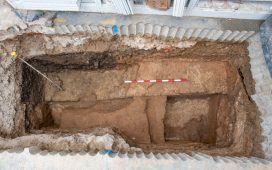All modern humans may have descended from people in what is now Botswana, according to scientists.
Researchers think they have, for the first time, discovered the ‘cradle of humanity’ where the first modern humans evolved before spreading across the globe.
They are believed to have flourished in the prehistoric Makgadikgadi–Okavango wetland, just to the south of the Zambezi River.
A study of DNA records and migration patterns has proven, scientists say, that the genetic root of all modern humans comes from that region 200,000 years ago.
The wetland was a warm, lush green Garden of Eden in which early humans thrived before migrating when the climate turned dry.
And direct descendants of these pioneers can still be found living in the arid Kalahari desert today.

Researchers believe this area, which is now Makgadikgadi Pans National Park, is where the last common ancestors of modern humans all over the world can be traced back to

Scientists say all the genes of modern humans can be traced back to a population which lived in the prehistoric Makgadikgadi–Okavango wetland, just to the south of the Zambezi River – the area is now the arid Makgadikgadi salt pan (pictured) and most people migrated away when the climate there changed

Professor Vanessa Hayes discussing the significance of the region with Headman ǀkun ǀkunta from an extended Ju/’hoansi family – Ikun is one of the more than 1,000 African people who allowed for their DNA to be analysed to trace the roots of modern man
‘It has been clear for some time anatomically modern humans appeared in Africa roughly 200,000 years ago,’ said the lead researcher, Professor Vanessa Hayes.
‘What has been long debated is the exact location of this emergence and subsequent dispersal of our earliest ancestors.’
Professor Hayes, from Sydney University, studied the DNA of more than 1,200 living African people to pinpoint the origin of modern humanity.
She took samples from people called the KhoeSan, who live in rural Africa and who are known to be the most closely related to the original humans, and people genetically linked to them.
Her team could trace common ancestors of all the distinct groups back to the Makgadikgadi area of Botswana, which they have deemed the origin of man.
The findings, published in the journal Nature, add to existing geological and fossil evidence that prove Lake Makgadikgadi was home to early humans.
In the past, scientists have suggested that smaller pockets of humans evolved in various places around Africa before spreading.
But Professor Hayes said the original humans evolved in the Makgadikgadi–Okavango wetland and remained there for a whopping 70,000 years.
‘There was a very large lake,’ she said. ‘By the time modern humans arrived it was breaking up into smaller ones – creating a wetland.’
And she claims ‘green corridors’ of vegetation grew out of the wetland, which developed from a lake twice the size of the 23,000-square-mile Lake Victoria in Tanzania and Uganda, allowing people to migrate north-east and south-west.

Professor Hayes and her colleagues suggest that, as the climate changed some 130,000 years ago and the wetlands where the humans lived began to dry out, they migrated to the north-east (blue and green arrows) and the south-west (deep purple arrow) of Africa. The L0a, L0k and L0d1’2 are different variations of the original ancestral genes known as L0

People still live in the Makgadikgadi Salt Pans, Botswana. It is groups like these whose DNA gave scientists an insight into how modern humans may have been born from populations in the south of Africa. (Pictured: A group of Basarwa hunter/gatherers depart together on a foraging expedition on the salt pan)

The researchers traced different populations of the KhoeSan people, who are known to be those most closely related to the first modern humans who emerged some 200,000 years ago in Africa
Wetland is one of the healthiest ecosystems for sustaining life and would have been abundant enough for the human species to become established.
The climate then changed, drying out the land and causing the wetland to become what is now a region of salt pans and desert – this forced people to migrate.
Professor Hayes said: ‘The first migrants ventured northeast, followed by a second wave of migrants who travelled southwest.
‘A third population remained in the homeland until today.
‘In contrast to the northeasterly migrants, the southwesterly explorers appear to flourish, experiencing steady population growth.’
Their success was most probably from adapting to marine foraging – even learning how to scoop up seafood, including fish, with their hands.

Professor Hayes learns how to make fire with Juǀ’hoansi hunters in the now dried homeland of the greater Kalahari of Namibia
Professor Hayes’s research is based on DNA studies of people living in the south of Africa which allowed them to track how closely people were related.
She studied something known as L0 mitochondrial DNA, which people inherit from their mother.
‘Mitochondrial DNA acts like a time capsule of our ancestral mothers, accumulating changes slowly over generations,’ she said.
‘Comparing the complete DNA code, or mitogenome, from different individuals provides information on how closely they are related.’
Her international team collected blood samples from 1,217 people to establish a comprehensive catalogue of the ‘L0’ lineage.
Professor Hayes said: ‘This enabled us to pinpoint the ancestral homeland of all humans. It is the first time the exact location has been identified.’















